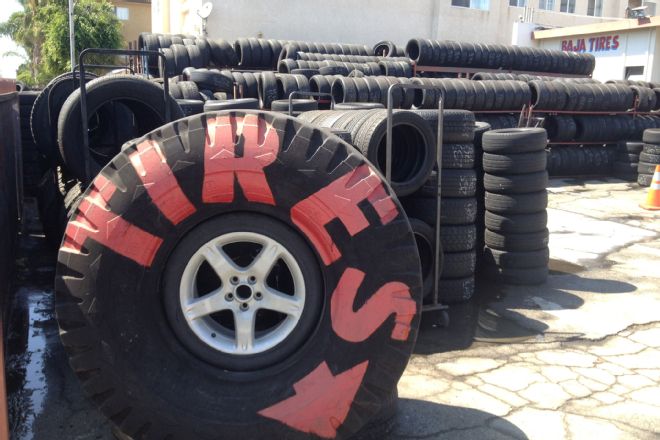
Almost every tire and certainly any you should be looking at, new or used, will have a series of numbers and letters on its sidewall that can tell you just about everything you need to know about that tire. These numbers, usually with a letter or letters in front, describe the its size, type, and construction.
The tires you will most likely be looking at are P-metric and LT. A tire with P in front of the series of numbers on the sidewall means that it’s a P-metric designed primarily for passenger vehicles that may include cars, SUVs, and light trucks (usually 1/2-ton). An LT (for instance, LT315/70R17) in front of the numbers tells you this is a Light Truck Metric meant for medium and heavy-duty (3/4 and 1-ton pickups and SUVs) trucks, and it’s designed to handle heavy loads. A tire with LT after the size numbers is for use on 1/2, 3/4, and 1-ton vehicles that haul heavy cargo or tow trailers, are flotation tires used for sand, or are extra wide tires meant for or use on 16.5-inch wide wheels.
Size Guide
The numbers following or preceding the P or LT can tell you the size of the tire. It’s not simple, but if you need to convert a Metric tire to a Society of Automotive Engineers (SAE) tire size, you can use this formula: ([Tire Width x Aspect Ratio x 2] / 2550 + Wheel Diameter) x (Tire Width / 25.4) – (Wheel Diameter). In other words, a LT315/70R17 is 34.4x12.4R17. The closest equivalent would be a 35/12.50R17LT and that tire’s size is somewhat of a no-brainer. It’s 35 inches tall, and the section width is 12 1/2 inches wide.
Tire Construction
If the tire is an LT315/70R17, the letter R after the aspect ratio number tells you that the tire is of radial construction. The letter D signifies that the tire is a bias ply (crossing each other on a diagonal from the wheel center). The number of plies (commonly 4 to 6, but in some military and commercial tires, can often be 10 or 12) is usually, but not always, stamped into the tire’s sidewall.
Maximum Load
The maximum load capacity is also molded into a tire’s sidewall. This load capacity is a function of the tire’s size (size of its air chamber), its construction (how much pressure it can hold), and the air pressure (how much air is inside the chamber).
Born On Date/Country Of Origin
You can also determine the tire’s age and country of origin from the Department of Transportation (DOT) Tire Identification Number (TIN), a set of up to 12 letters and numbers that begins with DOT on the sidewall. Since 2000, the week and year of a tire’s manufacture are the last four digits of the TIN. Prior to 2000, they only used three digits because they assumed tires would not be in service for more than 10 years. Face it though, if you’re looking at tires (new or used) older than 2000 at a swap meet or from some dude on eBay, it’s time to look at different tires.
Country of origin can be more difficult to determine. The manufacturer and plant code are the first two letters (or a number and letter, or two numbers) after DOT. Due to the increased number of manufacturers and plants in recent years, the DOT has instituted a three-number code for some tires. Plant codes can be found on the National Highway Traffic Safety Administration’s (NHTSA) website search page (nhtsa.gov/apps/manufacturer/index.htm). You can enter the manufacturer and the plant code into NHTSA’s searchable database for the information.
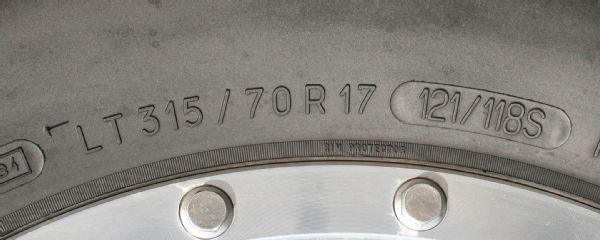 This LT315/70R17 has a 315mm section width (width across the widest point of its sidewalls) when at maximum cold inflation. One inch is equal to 24.5 mm, so 315 mm is 12.4 inches wide. The two numbers that follow the section width (70 in this example) is the aspect ratio (or profile). It indicates height of the sidewall (rim to tread) expressed in a percentage of the section width, which means the sidewall is 8.7 inches tall.
This LT315/70R17 has a 315mm section width (width across the widest point of its sidewalls) when at maximum cold inflation. One inch is equal to 24.5 mm, so 315 mm is 12.4 inches wide. The two numbers that follow the section width (70 in this example) is the aspect ratio (or profile). It indicates height of the sidewall (rim to tread) expressed in a percentage of the section width, which means the sidewall is 8.7 inches tall.
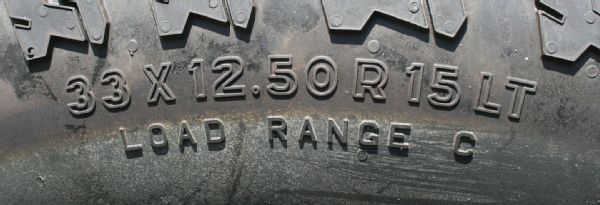 The letter R after the aspect ratio number tells you that the tire is of radial construction. That means the body plies (high-strength nylon, polyester, or steel thread belts) radiate out from the center. Radial tires are the most common today and the most structurally well adapted to highway and off-road travel for cars and light trucks.
The letter R after the aspect ratio number tells you that the tire is of radial construction. That means the body plies (high-strength nylon, polyester, or steel thread belts) radiate out from the center. Radial tires are the most common today and the most structurally well adapted to highway and off-road travel for cars and light trucks.
 The number after the profile on this 33x12.50R15LT (15 in this example) tells you the specified wheel diameter of the tire. There are 1/2-inch sizes as well. Tires also have rim-width ranges (the narrowest-to-widest rim it’s designed for) expressed in inches, but that is not usually found on the tire and must be sourced from the tire manufacturer or a retailer. The industry rule of thumb is that for every 1/2 inch change in rim width, the tire’s section width will change by 2/10 inch, but the tread width remains the same.
The number after the profile on this 33x12.50R15LT (15 in this example) tells you the specified wheel diameter of the tire. There are 1/2-inch sizes as well. Tires also have rim-width ranges (the narrowest-to-widest rim it’s designed for) expressed in inches, but that is not usually found on the tire and must be sourced from the tire manufacturer or a retailer. The industry rule of thumb is that for every 1/2 inch change in rim width, the tire’s section width will change by 2/10 inch, but the tread width remains the same.
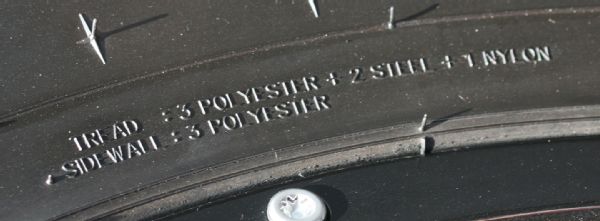 Some tires have a great deal of information on the sidewall concerning the number and type of plies used in the tire’s construction. This tire has three polyester, two steel, and a single nylon ply under its tread. It has three plies of polyester in its sidewall.
Some tires have a great deal of information on the sidewall concerning the number and type of plies used in the tire’s construction. This tire has three polyester, two steel, and a single nylon ply under its tread. It has three plies of polyester in its sidewall.
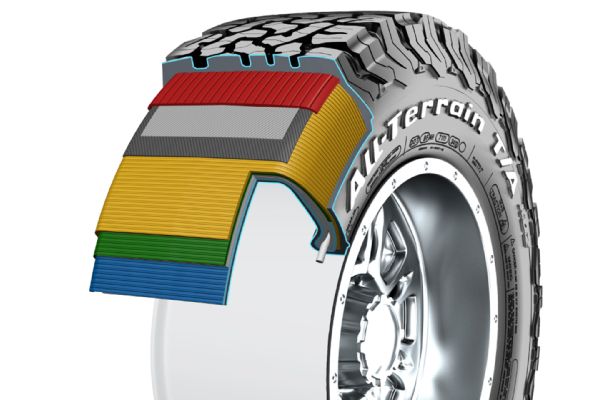 This cutaway drawing of the BFGoodrich All-Terrain T/A KO2 tire shows the bead (with its bead wire that strengthens the bead and helps to keep it seated) and its radial sidewall plies and three different tread plies (belts).
This cutaway drawing of the BFGoodrich All-Terrain T/A KO2 tire shows the bead (with its bead wire that strengthens the bead and helps to keep it seated) and its radial sidewall plies and three different tread plies (belts).
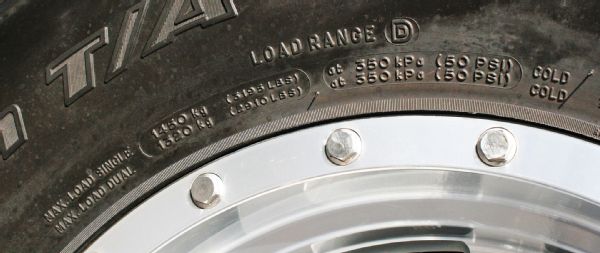 A tire’s load range is express using a letter (B, C, D, E, and F, for example), and these weight ranges can be found on major tire manufacturer’s website. However, more important is the maximum load (carrying weight) rating of the tire. This example tells you that the tire is rated for a maximum of 3,195 pounds of load at 50 psi (it’s maximum cold-air pressure rating) when used in a single-axle application. Just as important to know is that a tire’s maximum load carrying ability is inflation-pressure dependent and drops as the pressure is lowered.
A tire’s load range is express using a letter (B, C, D, E, and F, for example), and these weight ranges can be found on major tire manufacturer’s website. However, more important is the maximum load (carrying weight) rating of the tire. This example tells you that the tire is rated for a maximum of 3,195 pounds of load at 50 psi (it’s maximum cold-air pressure rating) when used in a single-axle application. Just as important to know is that a tire’s maximum load carrying ability is inflation-pressure dependent and drops as the pressure is lowered.
 This first two or three numbers or letters and last four numbers in the TIN on all DOT-approved tires sold in the USA can tell you the tire’s date of manufacture (born-on date) and the factory (city and country) in which it was made. This particular Toyo tire was made at the White, Georgia, plant (73 or 173) and was manufactured during the 51st week of 2012.
This first two or three numbers or letters and last four numbers in the TIN on all DOT-approved tires sold in the USA can tell you the tire’s date of manufacture (born-on date) and the factory (city and country) in which it was made. This particular Toyo tire was made at the White, Georgia, plant (73 or 173) and was manufactured during the 51st week of 2012.
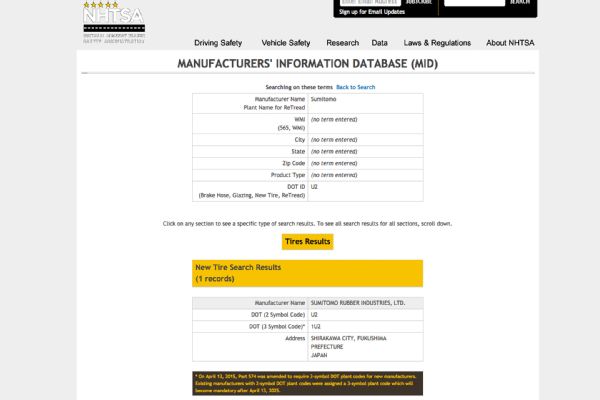 The best source of tire manufacturer information is the online NHTSA Manufacturer’s Database (nhtsa.gov/apps/manufacturer/index.htm). Through its search page you can enter the required numbers from the TIN and get the location of the plant in which any DOT-approved tire was made.
The best source of tire manufacturer information is the online NHTSA Manufacturer’s Database (nhtsa.gov/apps/manufacturer/index.htm). Through its search page you can enter the required numbers from the TIN and get the location of the plant in which any DOT-approved tire was made.